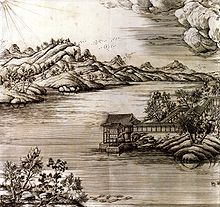- Matteo Ripa
-
 Morning Glow on the Western Ridge (西嶺晨霞); copperplate; (1711-1713) width 28 cm, height 45 cm. National Palace Museum, Taipei
Morning Glow on the Western Ridge (西嶺晨霞); copperplate; (1711-1713) width 28 cm, height 45 cm. National Palace Museum, Taipei
Matteo Ripa (29 March 1682, Eboli – 29 March 1746, Naples) was an Italian priest who was sent as a missionary to China by Propaganda Fide, and between 1711 to 1723 worked as a painter and copper-engraver at the Manchu court of the well-known Kangxi Emperor.
Ripa's Chinese students
In December 1723 Matteo Ripa left Beijing for Europe, travelling with four young Chinese Christians (Giovanni Gu (ca. 1700-1763), Giovanni Yin (ca. 1704-1735), Philipo Huang (ca. 1711 - 1776), and Lucio Wu (ca. 1712 - 1763)) and their Chinese teacher. His plan was to bring the youths to Naples, train them as priests, and let them go back to China as missionaries. This was the foundation of the "Collegio dei Cinesi" ("Chinese College"), sanctioned by Pope Clement XII to help the propagation of Christianity in China.[1]
All six travelers reached Italy by the way of Canton and London, where George I of England received them at his palace. Setting up a Chinese College in Naples turned out to be harder than Ripa thought, but eventually it was accomplished in 1732.
All four Ripa's Chinese seminarians were eventually ordained (Giovanni Gu and Giovanni Yin in 1734, Philipo Huang and Lucio Wu in 1741), but only three made it back to China.[1]
Ripa several times severely punished Lucio Wu for insubordination, and eventually, in June 1744, Ripa asked Propaganda not to send the young priest to position in China because of his "immaturity". Devastated, Lucio soon fled the college and disappeared, until Ripa found him in the monastery of Monte Cassino the following spring. Subject to disciplinary punishments, he soon fled again. He was arrested in September 1745 in Senigallia, after travelling with forged priest's credentials throughout the Papal States, and occasionally celebrating a Mass at various churches. This time, Lucio was sentenced to a year of imprisonment in the Chinese College. But Ripa felt that this was not enough. In a letter dated March 29, 1746 - the day of his death - Ripa asked Propaganda for life imprisonment for the Chinese priest. The cardinals obliged, and Lucio was imprisoned in Rome's Castel Sant'Angelo. His pleas for pardon were rejected by Propaganda, especially as Ripa's successor at the Chinese College, Fr. Fatigati, supported Ripa's negative assessment of Lucio. The Chinese priest died in Italy in 1763.[1]
References
- ^ a b c Mungello, David E. (2005). The Great Encounter of China and the West, 1500-1800. Rowman & Littlefield. pp. 119–123. ISBN 074253815X. http://books.google.com/books?id=9x3vE0UMPkMC.
External links
- Matteo Ripa, Memoirs of Father Ripa During Thirteen Years' Residence at the Court of Peking in the Service of the Emperor of China: With an Account of the Foundation of the College for the Education of Young Chinese at Naples (London: J. Murray, 1855)
Categories:- 1682 births
- 1746 deaths
- People from Eboli
- Italian Roman Catholic priests
- 18th-century Roman Catholic priests
- 18th-century Italian people
- Italian missionaries
- Italian painters
- Italian engravers
- Roman Catholic missionaries in China
- Italian painter, 17th century birth stubs
Wikimedia Foundation. 2010.

